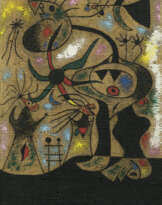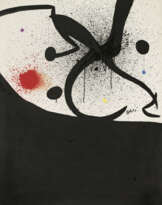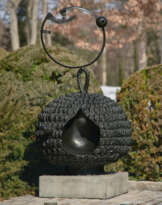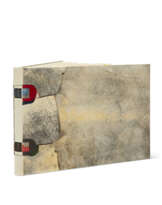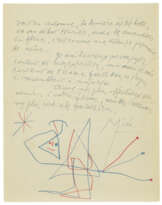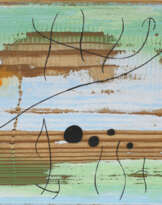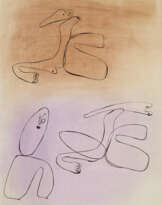ID 930307
Lot 153 | Joan Miró (1893-1983)
Estimate value
€ 80 000 – 120 000
Personnage à la plume
signé et numéroté 'Miró 2/6' (sur la base); avec la marque du fondeur 'Parellada' (au dos de la base)
bronze à patine brun vert
Hauteur: 34.5 cm.
Conçu en 1970; cette épreuve fondue ultérieurement dans une édition de 6 exemplaires
signed and numbered 'Miró 2/6' (on the base); with the foundry mark 'Parellada' (on the back of the base)
bronze with brown and green patina
Height: 13 3/8 in.
Conceived in 1970; this bronze cast at a later date in an edition of 6
Provenance
Galerie Lelong, Paris.
Collection particulière, Suisse (avant 2006).
Vente, Galerie Kornfeld, Berne, 15 juin 2012, lot 106.
Acquis au cours de cette vente par le propriétaire actuel.
Literature
F. Basile, Joan Miró, Bologne, 1997, p. 232 (une autre épreuve illustrée en couleurs, p. 233).
E. F. Miró et P. O. Chapel, Joan Miró, Sculptures. Catalogue raisonné, 1928-1982, Paris, 2006, p. 190, no. 189 (une autre épreuve illustrée en couleurs).
Special notice
Artist's Resale Right ("droit de Suite").
If the Artist's Resale Right Regulations 2006 apply to this lot, the buyer also agrees to pay us an amount equal to the resale royalty provided for in those Regulations, and we undertake to the buyer to pay such amount to the artist's collection agent.
ƒ: In addition to the regular Buyer’s premium, a commission of 5.5%
inclusive of VAT of the hammer price will be charged to the buyer.
It will be refunded to the Buyer upon proof of export of the lot
outside the European Union within the legal time limit.
(Please refer to section VAT refunds)
Post lot text
Les sculptures de Miró ont été le couronnement de la fin de sa carrière. Bien qu’il ait créé des objets peintures surréalistes durant la fin des années 1920 et 1930, ce n’est qu’une décennie plus tard, lorsqu’il vivait à Palma, Montroig et Barcelone pendant la Seconde Guerre mondiale, qu’il a décidé de créer de grandes silhouettes autonomes.
Conçu en 1970, Personnage à la plume résume l’approche spontanée et légère de Miró à la sculpture, intégrant les objets trouvés, dans une illustration radicalement abstraite du sujet titulaire de l’œuvre.
Sans commune mesure avec la réalité, Personnage à la plume, comme la majorité des œuvres de l’artiste, s’avère une tentative de Miró de simuler l’imagination à travers une autre forme de poésie visuelle. Malgré la nature durable des matières premières utilisées, Miró ranime le mouvement et la vie dans la silhouette à travers l’équilibre délicat de la plume et de la structure centrale.
En 1972, David Sylvester a fait remarquer que Miró est un sculpteur autodidacte, et non un sculpteur-né, ayant développé son talent pour les formes tridimensionnelles durant la cinquantaine. C’est peut-être pour cette raison que Miró a « tendance a faire plus confiance aux formes données des objets trouvés plutôt qu’à sa capacité à inventer des formes en ronde-bosse », nous explique Sylvester (D. Sylvester, Miró Bronzes, exh. cat., Hayward Gallery, Londres, 1972, p. 15).
Deux années plus tard, l’artiste a déclaré dans une interview avec un journal français « peindre, sculpter, graver, s’apparente peut-être à donner forme à un mythe, à produire une nouvelle réalité à partir d’un matériau donné, d’un objet physique donné qui oblige le geste à être transporté et placé dans le monde. Le réel naît tout d’un coup de cette épreuve. Rien n’est étranger à la peinture, à la gravure, à la sculpture : on peut travailler avec n’importe quoi – tout peut être utile. Si j’intègre régulièrement les objets tels qu’ils sont, avec les matières premières, ce n’est pas pour obtenir un effet plastique mais par nécessité. Cela permet de produire un choc entre une réalité et une autre… Je dois marcher sur ma terre, afin de vivre avec moi-même, car tout ce qui est répandu est nécessaire à mon travail » (tiré de R.-J. Moulin, L’Humanité, 25 mai 1974).
Miró’s sculptures were the crowning achievement of his late career. Although he had created surrealist objets peintures during the late 1920s and 1930s, it was not until a decade later, while he was living in Palma, Montroig and Barcelona during the Second World War, that he considered making large free-standing forms.
Conceived in 1970, Personnage à la plume encapsulates Miró’s spontaneous and playful approach to sculpture, incorporating objets trouvés, or found objects, in a radically abstracted depiction of the work’s titular subject.
A far cry from a representation of reality, Personnage à la plume, like much of the artist’s work, is Miró’s attempt to stimulate the imagination through a different kind of visual poetry. Despite the durable nature of the raw materials used, Miró breathes movement and life into the figure through the delicate balance of the feather and the central structure.
In 1972, David Sylvester observed that Miró was a self-made sculptor, not a born one, having developed his talent for three-dimensional form whilst in his fifties. It was perhaps for this reason, Sylvester explained, that Miró had a "tendency to put more trust in the given shapes of found objects than in his power to invent forms in the round" (D. Sylvester, Miró Bronzes, exh. cat., Hayward Gallery, London, 1972, p. 15).
Two years later, the artist stated in an interview with a French newspaper, "To paint, to sculpt, to etch, is maybe to give form to a myth, to produce a new reality from a given material, from a physical thrust that forces a gesture to be carried and placed in the world. The real suddenly appears from this struggle. Nothing is foreign to painting, to etching, to sculpture: one can work with anything - everything can be useful. If I frequently integrate the objects as they are, with raw materials, it is not to obtain a plastic effect but by necessity. It is in order to produce the shock of one reality against another…I need to walk on my earth, to live among my own, because everything that is popular is necessary for my work" (quoted in R.-J. Moulin, L’Humanité, 25 May 1974).
| Artist: | Joan Miró (1893 - 1983) |
|---|---|
| Applied technique: | Metalwork |
| Medium: | Bronze |
| Artist: | Joan Miró (1893 - 1983) |
|---|---|
| Applied technique: | Metalwork |
| Medium: | Bronze |
| Address of auction |
CHRISTIE'S 9 Avenue Matignon 75008 Paris France | ||||||||||||||
|---|---|---|---|---|---|---|---|---|---|---|---|---|---|---|---|
| Preview |
| ||||||||||||||
| Phone | +33 (0)1 40 76 85 85 | ||||||||||||||
| Fax | +33 (0)1 40 76 85 86 | ||||||||||||||
| Conditions of purchase | Conditions of purchase | ||||||||||||||
| Shipping |
Postal service Courier service pickup by yourself | ||||||||||||||
| Payment methods |
Wire Transfer | ||||||||||||||
| Business hours | Business hours
|











